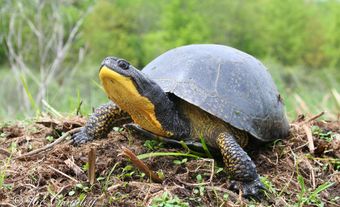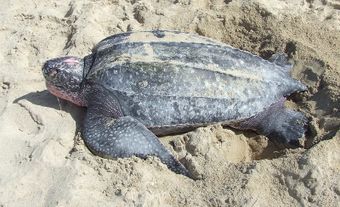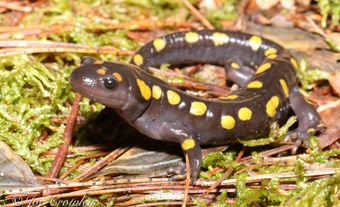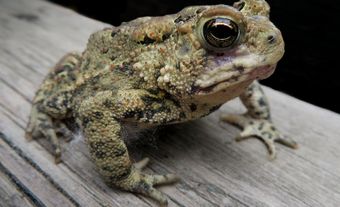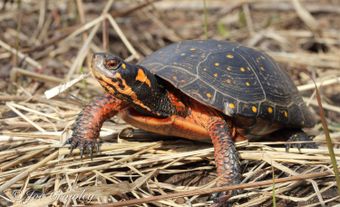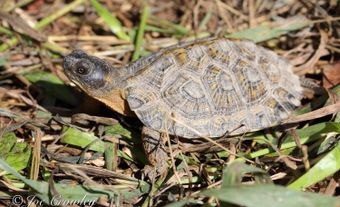Turtles are reptiles with a bony shell that belong to the order Testudines. Turtles have been very successful from an evolutionary standpoint and have persisted, relatively unchanged, since they first evolved more than 200 million years ago. Eight species of freshwater turtles and four species of sea turtles can be found in Canada. In addition, two species — the Pacific pond turtle and the eastern box turtle — are extirpated. This means that, while they continue to live in other parts of their range, they are no longer found in Canada. There are 14 extant taxonomic families of turtles worldwide, six of which are found in Canada: Chelydridae (snapping turtles), Trionychidae (softshell turtles), Kinosternidae (musk and mud turtles), Emydidae (pond and marsh turtles), Dermochelyidae (leatherback sea turtle) and Cheloniidae (hard-shelled sea turtles). In Canada, turtles are found from coast to coast, from the Atlantic Ocean to the Pacific Ocean, although they are absent from the territories in the North.

Turtle Species in Canada
|
Common Name |
Scientific Name |
Subspecies |
Provinces/Territories |
|
Emydoidea blandingii |
|||
|
Chrysemys picta |
Eastern painted turtle (Chrysemys picta picta)
Midland painted turtle (Chrysemys picta marginata) Western painted turtle (Chrysemys picta bellii) |
||
|
Eastern musk turtle |
Sternotherus odoratus |
ON, QC |
|
|
Green sea turtle |
Chelonia mydas |
||
|
Kemp’s ridley sea turtle |
Lepidochelys kempii |
Atlantic Ocean |
|
|
Dermochelys coriacea |
Atlantic Ocean, Pacific Ocean |
||
|
Loggerhead sea turtle |
Caretta caretta |
Atlantic Ocean |
|
|
Northern map turtle |
Graptemys geographica |
ON, QC |
|
|
Chelydra serpentina |
SK, MB, ON, QC, NB, NS |
||
| Spiny softshell |
Apalone spinifera |
Eastern spiny softshell (Apalone spinifera spinifera) |
ON, QC |
|
Clemmys guttata |
ON |
||
|
Glyptemys insculpta |
ON, QC, NB, NS |

Description
Turtles are best known for their shells, which are made up of bony plates fused to an enlarged ribcage. The upper shell is called the carapace, while the bottom shell is called the plastron. In most species, the shell is covered in horny plates called scutes. However, softshell turtles and leatherbacks have greatly reduced bony plates and lack scutes and their shells are covered by tough, leathery skin. Turtles have relatively long necks, four limbs and a tail, all of which can be pulled back into the shell for protection. Some species, such as snapping turtles, have greatly reduced plastrons, making it impossible for them to fully retreat into their shells. Conversely, other species like Blanding's turtles and eastern musk turtles have hinges on their plastrons, allowing them to partially or fully close their shells after disappearing inside.
Like other non-avian reptiles, their skin is covered in scales, which provide protection and help reduce water loss in dry environments. Turtles do not have teeth; instead, their jaws form sharp beaks that they use to slice and tear their food. Turtles have lungs and breathe air. Most species have large claws, which are used for digging or, in some cases, even climbing. Aquatic turtles typically have webbing between their toes that help them swim, while the limbs of marine turtles have evolved into flippers that increase their manoeuvrability in the water. Turtles have excellent eyesight, hearing and chemoreception (smell). Some species, such as loggerhead and leatherback sea turtles, can also detect the earth’s magnetic field and use it to orient themselves and navigate their environment.
Although all turtles have a similar body plan, there is considerable variation in size and appearance among Canada’s turtles, ranging from the tiny spotted turtle (14 cm carapace length) to the prehistoric-looking snapping turtle (50 cm carapace length) to the enormous leatherback sea turtle (which can weigh over 900 kg).
Did you know?
The name “tortoise” refers to the terrestrial turtles of the family Testudinidae, none of which are found in Canada.
Physiology and Overwintering
Turtles are ectotherms, meaning that they do not generate their own body heat. Instead, their body temperature is dependent on their environment. They regulate their body temperature through behaviour and habitat use, such as basking on a sunny log. This is known as “behavioural thermoregulation.” Winter temperatures in northern temperate regions are too cold for continued activity or survival, so freshwater turtles hibernate underwater in rivers, lakes and wetlands. During the winter, a freshwater turtle’s body temperature remains similar to the surrounding water temperature —usually just above 0°C (see Blanding’s turtle). At these low temperatures, their metabolism slows drastically, allowing turtles to survive for months without eating or surfacing for air. Instead, the turtle can get all the oxygen it needs by absorbing it through the lining of its mouth and cloaca (the opening under the tail used for mating and excreting waste), which is called “cutaneous respiration.” Sea turtles, on the other hand, migrate south to warmer latitudes during Canadian winters.

Distribution and habitat
Since turtles are ectotherms, Canada’s cool climate imposes major constraints on where they can live. For example, turtle eggs require a certain amount of heat throughout their incubation period to develop and hatch. If summer temperatures are too low or if the cool fall weather sets in too quickly, the eggs won’t hatch. For this reason, most turtles are restricted to the southernmost parts of Canada, where temperatures are warmest. Not surprisingly, southern Ontario and southern Quebec are home to the highest number of turtle species in Canada.
Canada’s freshwater turtles primarily live in aquatic habitats, such as rivers, lakes, ponds, streams and wetlands. The specific habitats used vary by species. For example, wood turtles inhabit rivers and streams, while Blanding's turtles live in shallow wetland habitats. Freshwater turtles dig their nests in a variety of habitats, including along sandy shorelines of rivers and lakes, forest clearings and even rocky outcrops.
Sea turtles are found along Canada’s Atlantic and Pacific coasts during the spring, summer and fall. Females that forage in Canadian waters nest on sandy ocean beaches in the U.S. and at tropical latitudes, such as in the Caribbean. Sea turtles can have extremely large home ranges, with some individuals travelling more than 10,000 km each year.
Females often demonstrate strong fidelity to nest sites, meaning that they typically return to the same sites year after year.

Reproduction and Development
Freshwater turtles typically mate in the spring, although mating may also occur throughout the summer and fall. Sea turtles mate prior to and during the nesting period. Fertilization is internal, and females are capable of storing viable sperm for several years. All turtle species lay eggs. In Canada, female freshwater turtles lay their eggs from late May to mid-July, while sea turtles nest at different times of the year, depending on the species and location. The number of eggs varies by species, from as few as one to seven (spotted turtles) to several hundred (sea turtles). The eggs hatch after an incubation period of 1.5–3.5 months, depending on the species and location. Eggs of freshwater species in Canada hatch in the late summer or early fall, while the hatching dates for sea turtle eggs vary. Hatchlings of some species, such as painted turtles, may remain in the nest cavity over the winter — sometimes enduring freezing for short periods — and emerge the following spring. Females do not usually reproduce yearly; their reproductive frequency can range from one to four years.
Did you know?
Most of Canada’s turtles have temperature-dependent sex determination (TSD), meaning that the sex of the offspring is determined by the incubation temperature of the eggs. Most of Canada’s turtles have a TSD-1a pattern, in which cooler temperatures produce males and warmer temperatures produce females. The eastern musk turtle, on the other hand, has a TSD-2 pattern, with females being produced at both cool and warm temperatures and males at intermediate temperatures. The spiny softshell and wood turtle are the only two Canadian species with genetic sex determination.
Turtles are extremely long-lived, and individuals of some species can live for more than 100 years (e.g., spotted turtles). However, they do not reach sexual maturity until they are 6 to 35 years of age, depending on the species. Eggs and hatchlings have very low survival rates, and it is common for entire nests to be consumed by predators or fail to hatch due to cool weather. As a result, very few eggs will survive to adulthood — less than 0.07% in snapping turtle populations in places like Algonquin Provincial Park. Based on this, producing a single adult snapping turtle would take around 1,400 eggs, representing several decades of reproductive effort. This means that turtle populations grow very slowly, making long adult lifespans necessary to maintain stable populations.

Diet and Predation
Most of Canada’s turtles are omnivorous and eat a wide variety of foods, including small vertebrates (e.g., amphibians and fish), invertebrates (e.g., insects, crustaceans and worms), plants, algae and carrion (dead animals). Some species are carnivorous, however, and have very specialized diets. For example, leatherback sea turtles feed almost exclusively on jellyfish, while female northern map turtles often specialize in eating molluscs (snails and mussels).
The main predators of adult and juvenile freshwater turtles and their nests are mammals, including raccoons, foxes, skunks, otters, mink and bears. Predators of adult and juvenile sea turtles include sharks and other fish, saltwater crocodiles, orcas and seals. In contrast, sea turtle nests are consumed by mammals, insects, snakes, crabs and birds. A wide variety of predators eat hatchling turtles, including mammals, birds, lizards, snakes, toads, crabs, insects, jellyfish and squid. Humans are also major predators of adult turtles and their nests, particularly in the case of sea turtles.
Role in Ecosystem
Turtles can occur in high densities relative to other vertebrate groups (e.g., mammals and other reptiles), making them an integral part of their ecosystems. As herbivores, omnivores and carnivores, turtles play an important role in food webs, including regulating prey populations and shaping community structure and composition. By scavenging for and consuming dead animals, turtles also help keep wetlands, rivers and lakes clean. On the other hand, turtles and their eggs are an important food source for a wide variety of other species. Turtles also contribute to energy flow between aquatic and terrestrial ecosystems. For example, the consumption of turtle eggs by predators can result in the redistribution of significant amounts of energy and nutrients from aquatic to terrestrial environments, particularly in areas where nest predation is common. Turtles also contribute to various other ecosystem processes, including mineral cycling, seed dispersal and seed germination.
Cultural Significance
Turtles have significant cultural importance and are enshrined in many belief systems and customs worldwide, including in Canada. For many Indigenous communities, turtles symbolize life and represent a deep connection with the land. For example, the creation story of some Indigenous communities, particularly in northeastern North America, describes the world being created on the back of a turtle, resulting in the continent being referred to as “Turtle Island.”
Status and Threats
Turtles have roamed the earth for more than 200 million years and survived many cataclysmic events, including the mass extinction of the dinosaurs. However, human activity is causing widespread biodiversity loss and ushering in a new mass extinction, which now threatens the survival of many turtle species. The major threats to turtle populations, both globally and within Canada, include habitat loss and fragmentation, road mortality, illegal collection and climate change. The turtle’s shell — a body plan that has been successful for millions of years — provides little protection from human-caused threats. Furthermore, because of their long adult lifespans and slow reproduction, the death or removal of even a small number of adults each year can cause population declines, making turtle populations especially vulnerable to many of the threats they now face. Because of this, turtles are experiencing significant declines. Globally, 47.9 per cent of the world’s turtle species are considered to be threatened with extinction. All eight extant freshwater turtle species in Canada, as well as two of the marine turtle species, are listed on Schedule 1 of the federal Species at Risk Act.


 Share on Facebook
Share on Facebook Share on X
Share on X Share by Email
Share by Email Share on Google Classroom
Share on Google Classroom

